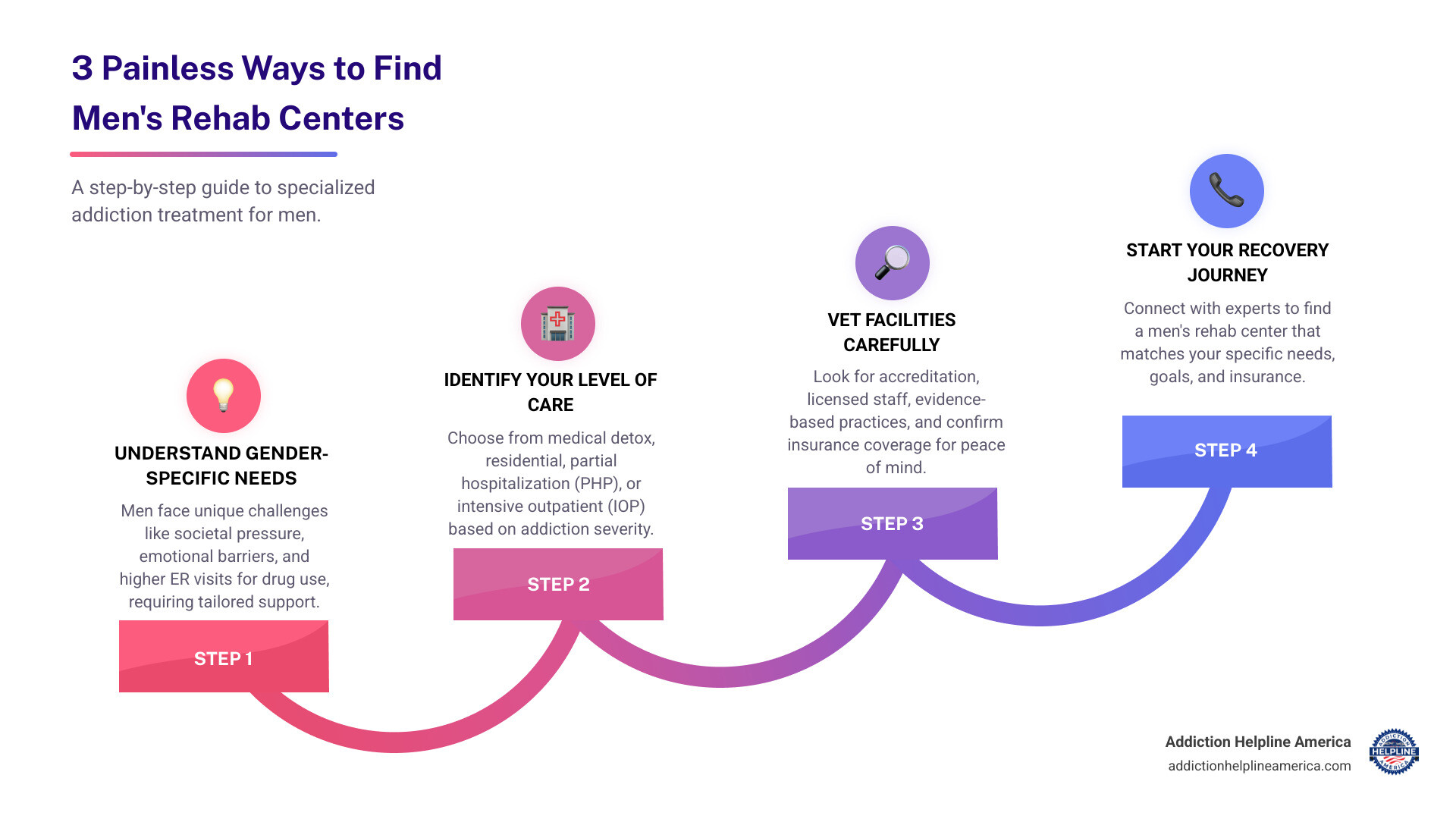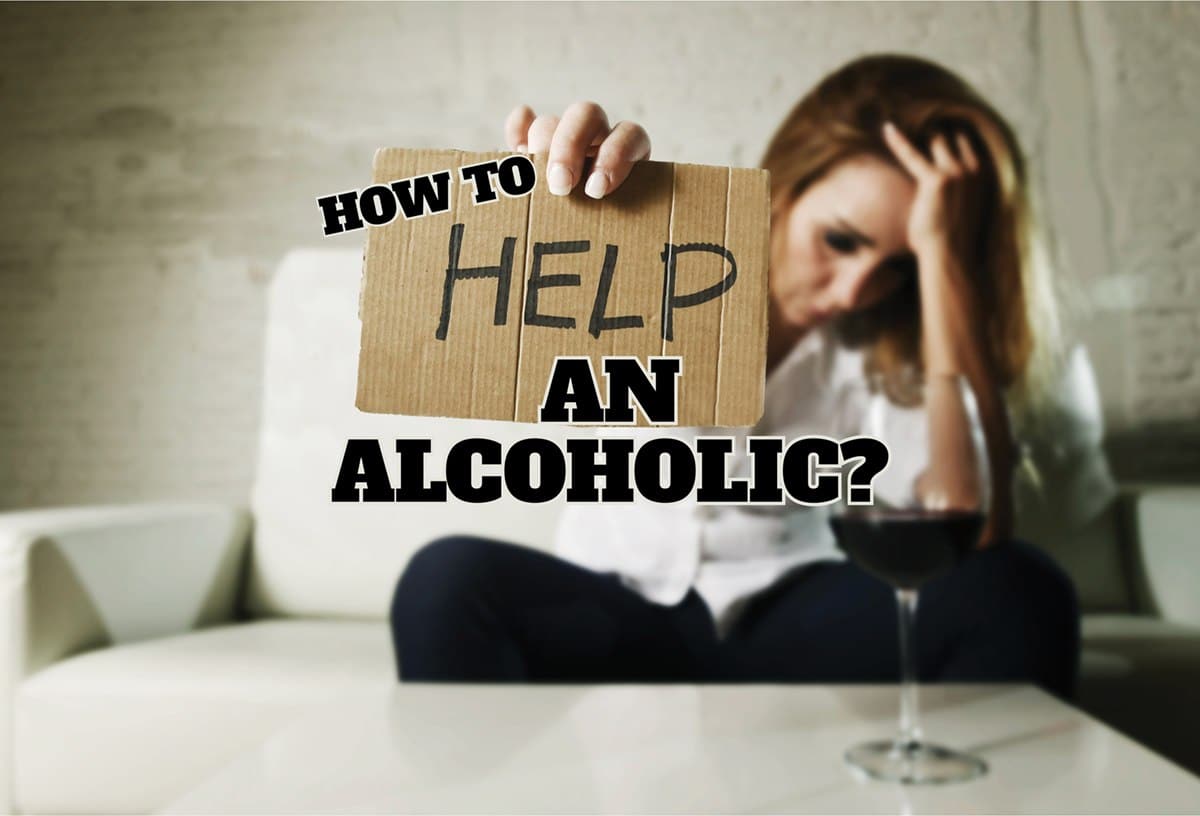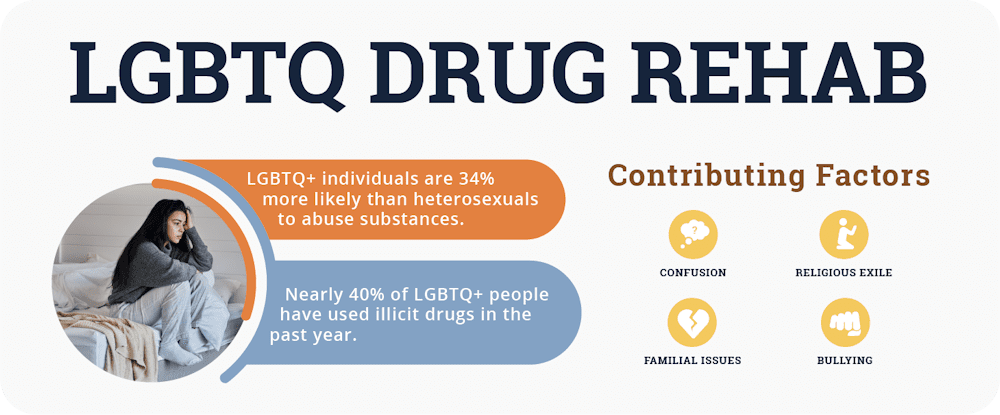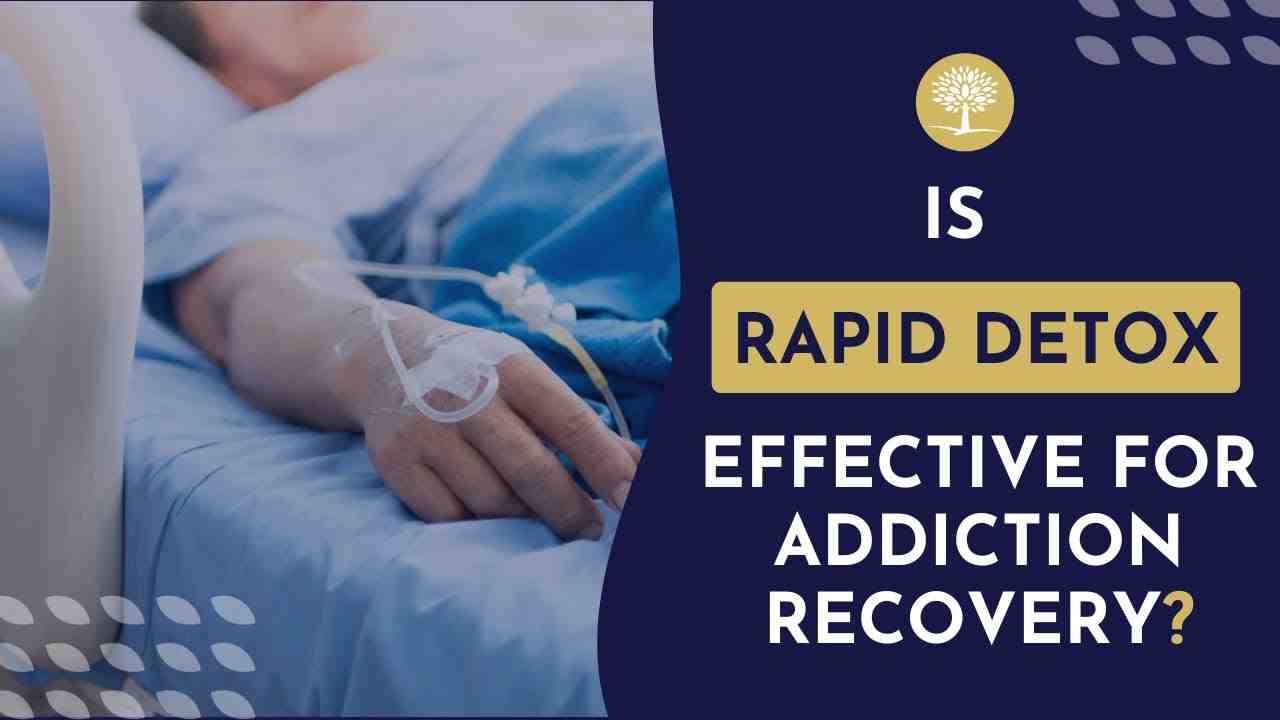
Why Finding the Right Men’s Rehab Center Matters
Men’s rehab centers provide specialized addiction treatment designed specifically for men’s unique recovery needs. If you’re looking for help right now, here’s what you need to know:
Quick Answer: How to Find Men’s Rehab Centers
- Understand why gender-specific treatment works – Men face distinct challenges like societal pressure to appear strong, difficulty expressing emotions, and higher rates of ER visits due to illicit drug use
- Identify your level of care – Choose from detox, residential, partial hospitalization (PHP), or intensive outpatient (IOP) based on addiction severity
- Vet facilities carefully – Look for accreditation, licensed staff, evidence-based practices, and verify insurance coverage
Men experience addiction differently than women. Research shows men are more likely to visit the emergency room for drug use, have higher overdose death rates, and face more severe alcohol withdrawal symptoms. Yet societal expectations often make it harder for men to admit they need help.
Gender-specific rehab programs create safe spaces where men can address addiction without the stigma of appearing “weak.” These programs tackle issues like trauma, anger management, and workplace stress in ways that resonate with male experiences. Men in these settings often feel more comfortable opening up, leading to better long-term outcomes.
The path to recovery starts with finding the right facility. Some men need medical detox for safe withdrawal management. Others benefit from residential treatment with 24/7 support. Many succeed in outpatient programs while maintaining work and family responsibilities.
At Addiction Helpline America, we’ve helped thousands of men and their families steer the overwhelming process of finding quality treatment. Our team specializes in connecting men with men’s rehab centers that match their specific needs, insurance coverage, and recovery goals.

Men’s rehab centers vocab explained:
Step 1: Understand Why a Men’s Program Is the Right Choice
When it comes to addiction and recovery, men face a unique set of challenges that differ significantly from what women experience. This isn’t about one journey being harder than the other—it’s about recognizing that biological factors, psychological patterns, and societal expectations shape how men experience addiction and what they need to recover successfully. Understanding these differences is your first step toward finding effective treatment at men’s rehab centers.
Addiction is a complex but treatable disease that affects the brain and behavior. It can involve drugs, alcohol, prescription medications, or even behavioral patterns like gambling. For men specifically, these struggles often get tangled up with pressures that society places squarely on their shoulders. The statistics paint a sobering picture: men are more likely to end up in the emergency room because of illicit drug use, and they face higher overdose death rates than women. In 2021 alone, 46.3 million Americans aged 12 or older struggled with a substance use disorder, and 16.8 million males in that age group had an alcohol use disorder. Between 2021 and 2022, overdose deaths among men actually increased by 1.1%, while they decreased for women. These aren’t just numbers on a page—they represent real people, real families, real communities from coast to coast.
One major factor driving men’s substance use is peer pressure, which often pushes men toward risky behaviors they might otherwise avoid. Men also typically experience more severe withdrawal symptoms from alcohol than women do. But here’s some encouraging news: once men commit to treatment, they often show remarkable staying power. Research shows that men treated for alcohol use disorder are actually less likely to relapse and tend to have longer periods of abstinence than women. That resilience is real, and it’s powerful.
Call now – your recovery starts here!

The challenge, though, is getting men through the door in the first place. Traditional societal expectations have created a harmful stigma around men seeking help. Admitting you’re struggling with addiction or co-occurring mental health issues like depression, anxiety, or PTSD can feel like admitting weakness—and many men have been taught their whole lives that weakness isn’t acceptable. As a result, men are statistically less likely than women to reach out for help with mental health conditions, even when those conditions are directly fueling their substance use. The Substance Abuse and Mental Health Services Administration (SAMHSA) has highlighted how the physical, psychological, social, and spiritual effects of substance use on men require different approaches than those used for women. For a deeper look at these differences, you can explore scientific research on sex and gender differences in substance use. To better understand how treatment specifically addresses men’s needs, SAMHSA’s guide on Addressing the Specific Behavioral Health Needs of Men offers valuable insights.

Benefits of Gender-Specific Men’s Rehab Centers
This is exactly where gender-specific men’s rehab centers make all the difference. They’re designed from the ground up to meet the unique needs we’ve been talking about.
In a men-only environment, something shifts. That pressure to maintain a facade of toughness or “performative masculinity” starts to fade away. Men can actually talk openly about their experiences with addiction, trauma, grief, and emotional pain without worrying about being judged or appearing weak. These become safe spaces where vulnerability isn’t just accepted—it’s encouraged and respected.
The treatment itself is custom-built to address how men think, feel, and struggle with addiction. Programs tackle issues that hit close to home for many men: anger management, the challenges of fatherhood, workplace stress, and the weight of societal expectations that may have contributed to substance use in the first place. When treatment speaks directly to your experience, it just works better.
There’s also something powerful about the community and brotherhood that develops in men’s rehab centers. This peer support becomes invaluable, helping men combat the isolation and shame that so often accompany addiction. When you’re sharing your story with other men who truly understand what you’re going through, it builds bonds that can last a lifetime. That support network becomes essential for long-term recovery.
For some men, especially in early recovery when focus is critical, a men-only setting means reduced distractions. Without the social dynamics that come with co-ed environments, men can dive deeper into their therapeutic work without their attention being pulled elsewhere.
The therapy itself becomes more focused on male experiences. Group sessions can explore topics like emotional expression, healthy coping mechanisms, and relationship challenges in ways that resonate specifically with men’s lives. Therapists can address issues around fatherhood, anger, and workplace pressures without having to balance different gender perspectives in the same room.
Perhaps most importantly, these environments genuinely foster vulnerability. We’ve seen time and again that when men are in all-male groups, they communicate more openly and engage more fully with treatment. The social stigmas and expectations that held them back start to lose their grip, opening the door to real, deep healing.
Unique Challenges Men Face in Recovery
While men have tremendous capacity for long-term recovery once they commit to it, the path to that commitment is often blocked by specific obstacles. Understanding these challenges helps explain why specialized men’s rehab centers are so important.
The stigma of weakness looms large. Society has long told men they should be stoic, self-reliant, and always in control. Admitting to addiction or asking for help can feel like a profound failure—like you’re breaking some unspoken rule about what it means to be a man. This stigma keeps countless men from seeking the help they desperately need.
Many men also struggle with difficulty expressing emotions beyond anger or frustration. If you weren’t taught healthy ways to process and share your feelings, substances can become the go-to coping mechanism. This emotional repression makes it harder to engage in therapies that require you to open up and be vulnerable. The weight of all those unexpressed emotions can feel crushing.
Trauma differences also play a role. While everyone can experience trauma, the types men face and how society responds to them often differ. Men have historically faced higher rates of military combat trauma and occupational injuries, both of which can fuel substance use disorders. Addressing these specific trauma experiences requires treatment approaches that understand the male experience.
Workplace pressures add another layer of stress. Many men feel intense pressure to be the primary provider for their families, leading to long hours, constant stress, and a very real fear that if their addiction becomes known, they’ll lose their job. Seeking treatment can feel like risking everything—your income, your family’s security, your sense of identity and purpose.
Finally, justice system involvement disproportionately affects men, and substance use often plays a central role in these legal troubles. The fear of legal consequences can become yet another barrier preventing men from reaching out for help, even when they know they need it.
Overcoming these challenges requires a supportive, understanding environment specifically designed for men. Programs like a men’s residential program offer the focused, gender-specific care needed to steer these unique obstacles and build a foundation for lasting recovery.
Call now – your recovery starts here!

Step 2: Identify the Right Level of Care and Program Type
Once you understand why a gender-specific approach might be the best fit, the next step is figuring out which type of program will actually work for your situation. Here’s the truth: addiction treatment isn’t one-size-fits-all. It’s more like a spectrum, ranging from intensive medical supervision around the clock to flexible programs that let you keep working and living at home.
The severity of the addiction, any co-occurring mental health issues (like depression or anxiety), personal circumstances (like job responsibilities or family obligations), and your support system all play a role in determining the most effective path forward. Some men need to start with medical detox because stopping cold turkey could be dangerous. Others might benefit most from residential treatment where they can focus entirely on recovery without outside distractions. And many men find success in outpatient programs that allow them to maintain their daily responsibilities while getting the help they need.
At Addiction Helpline America, we believe in personalized solutions. We look at the whole picture—your unique situation, your specific needs, and what’s realistically going to work for your life. Resources like SAMHSA’s document on Addressing the Specific Behavioral Health Needs of Men guide us in ensuring that the treatment plan is as unique as the individual seeking help.

Levels of Addiction Care Explained
Understanding the different levels of care is crucial for making an informed decision about men’s rehab centers. Let’s break down what each level looks like and who it’s designed to help.
Medical Detox is the most intensive level of care, with 24/7 medical supervision. This typically lasts 3-10 days, depending on the substance and how severe the dependence is. This level is essential for individuals with severe physical dependence on substances, those at risk of dangerous withdrawal symptoms (like delirium tremens from alcohol), or those coming off opiates or benzodiazepines. If you’ve been using heavily for a long time, detox is often the crucial first step. The medical team manages withdrawal symptoms and keeps you safe during what can be a physically challenging time. For men who need this level of care, facilities like New Dawn Treatment Center Men’s Detox provide specialized support.
Inpatient or Residential Treatment comes next in intensity. This is where you live at the facility full-time, typically for 30 to 90 days, sometimes longer. You’ll have structured therapy sessions throughout the day, group activities, and round-the-clock support. This level works best for men who need to step away from their environment completely—whether that’s because of triggers at home, lack of a stable living situation, or the need for intensive therapeutic intervention. The immersive nature of residential treatment allows you to focus entirely on recovery without the distractions and stresses of everyday life. Programs like Pyramid Healthcare Men’s Inpatient Treatment Center offer this comprehensive approach specifically designed for men.
Partial Hospitalization Programs (PHP) offer a middle ground. You attend treatment during the day (usually 5-6 hours, five days a week) but return home in the evenings. This level provides intensive therapy and support while allowing you to maintain some connection to your daily life. It’s ideal for men who have completed residential treatment and are stepping down, or for those whose addiction is serious but who have a stable, supportive home environment.
Intensive Outpatient Programs (IOP) are the most flexible option. You typically attend therapy sessions 3-4 days a week for a few hours each day. This allows you to continue working, going to school, or taking care of family responsibilities while still getting structured support. IOP works well for men with less severe addictions, those stepping down from higher levels of care, or those who simply can’t take extended time away from their responsibilities.
The key is finding the right fit. Too little structure and support can lead to relapse. Too much can feel overwhelming or unnecessary. That’s why we take the time to understand your specific situation before making recommendations.
Call now – your recovery starts here!

Specialized Programs and Therapies for Men
Beyond the level of care, men’s rehab centers offer specialized programs and therapies designed to address the unique ways men experience and recover from addiction.
Dual diagnosis treatment is critical for many men. This addresses both substance use disorders and co-occurring mental health conditions like depression, anxiety, PTSD, or trauma. Since men are statistically less likely to seek help for mental health issues due to stigma, addressing both simultaneously in a safe, men-only environment can be transformative. You’re not just treating the addiction—you’re treating the underlying pain that often fuels it.
Many facilities offer both 12-Step and Non-12-Step approaches. The 12-Step model, based on programs like Alcoholics Anonymous, emphasizes spiritual principles and peer support. Non-12-Step programs might focus more on self-empowerment, cognitive behavioral approaches, or alternative philosophies. Neither is inherently better—it’s about what resonates with you personally.
Group therapy dynamics in men-only settings are particularly powerful. When men gather without the pressure of performative masculinity, they often open up in ways they wouldn’t in co-ed settings. Discussions can focus on shared male experiences—fatherhood, workplace pressures, anger, vulnerability, and healthy masculinity. This brotherhood and camaraderie become a cornerstone of recovery.
Specific therapies that often resonate strongly with men include anger management programs, which teach healthy ways to process and express anger rather than turning to substances. Communication skills training helps men articulate emotions they may have suppressed for years. Many men find they’ve never learned how to express feelings beyond anger or frustration, and learning this skill is life-changing.
Holistic therapies like adventure therapy, exercise programs, mindfulness practices, and experiential therapies can be especially effective for men who struggle with traditional talk therapy. These approaches engage the body and mind together, providing alternative pathways to healing.
Pharmacological therapies also play a role for many men. Medications like buprenorphine or methadone for opioid addiction, naltrexone for alcohol use disorder, or medications to manage co-occurring mental health conditions can be part of a comprehensive treatment plan. The stigma around medication-assisted treatment is fading as we recognize that addiction is a medical condition that sometimes requires medical intervention.
The most effective programs combine multiple approaches custom to each individual. That’s the beauty of specialized men’s rehab centers—they understand that treating men’s addiction requires addressing not just the substance use, but the whole person and the unique challenges men face.
Our helpline is 100%
free & confidential
If you or someone you care about is struggling with drug or alcohol addiction, we can help you explore your recovery options. Don’t face this challenge alone—seek support from us.
Programs
Resources
Will my insurance
cover addiction
treatment?
We're ready to help
Find the best
drug or alcohol treatment
center
Are you or a loved one struggling with addiction? Call today to speak to a treatment expert.
















